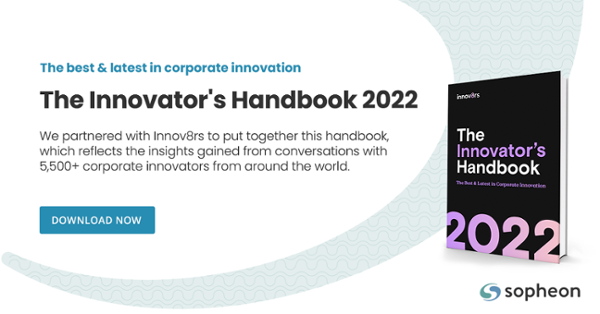Reading time: 8 minutes
The best ideas and innovations go nowhere without financial backing. In the corporate world, that means gaining support and funding from the executive management team.
Change is a constant in the corporate world. The average length of a company’s tenure in today's Dow Jones Industrial Average is only 15 to 20 years, far shorter than was in the decades preceding the development of microprocessors in the 1970s. It’s the same story at the S&P 500, where there’s “a steady churn rate of companies dropping off the index as new entrants join the list, and corporate lifespans continue their downward trajectory.” Successful companies that stop innovating end up in the rearview mirror.
Innovation entails a two-pronged strategy. On the one hand, you have ongoing innovation and improvements to the existing products and lines of business that are the lifeblood of the company. This is often called core or incremental innovation. Incremental innovation builds on what you already know and do.
On the other hand, you have ideas that are considered new, different, or radical. These have the potential to transform your business—and perhaps even create new markets and business models. Innovation of this type is often called radical innovation.
Ideas around core innovation are more easily funded than ideas around radical innovation. The progress of core innovation ideas to the market involves selection (among all the core ideas), prioritization, and execution. Radical innovation is different. Most ideas that fall into the radical innovation bucket will never make it to market. Some would say that such ideas “failed,”— but that’s an inaccurate and damaging label. We need to expect that radical innovation ideas won’t make it and learn from them.
To keep innovating and moving the business forward, executives need to invest in both types of innovation. But getting the investment for radical innovation is often easier said than done.
Here are three essential steps you should consider to earn support and funding sources for radical innovation:
1. Develop clear messaging of the vision and purpose for radical innovation
As Outcome co-founder Cris Beswick pointed out on the Innovation+ Talks podcast, the leadership and cultural shifts required for organizations to take on radical innovation projects are often seen as steep scary mountains to climb. The most successful innovation leaders articulately convey new initiatives' challenges, threats and opportunities. Let’s use Microsoft’s Satya Nadella as an example.
The emergence of open-source software and cloud computing in the 2000s radically transformed market dynamics. Had Microsoft continued to rely on its proprietary operating system and Office suite for revenue, the company would be a vastly diminished organization today. Nadella immediately made a compelling case for radical innovation projects centered on cloud computing, an area where the company had fallen far behind competitors.
In Nadella’s first company appearance, Fortune reported, “He tried to convey the sense that the legendary tech giant could be cool and innovative.” Nadella’s bold vision and purpose have proven wildly successful in the eight years since that address. Microsoft’s Intelligent Cloud business, one of the company’s three broad segments today, generated $18.3 billion in revenue in Q2 FY 2022. That’s a 25% jump from the previous year and over 35% of Microsoft’s total revenue.
The first step is to lock down your messaging, value and purpose. To secure funding and support from the executive team, you need a message that conveys both the upside of the new innovation and the threat to the business if competitors get to market first.
2. Funding for radical innovation
The best ideas and innovations go nowhere without financial backing. In the corporate world, that means gaining support from the executive management team and the board of directors. In addition to the compelling vision addressed above, you need a financial plan that will show progress and projected results.
In an Innovation+ Talks podcast, noted entrepreneur and author Esther Gons referred to Eric Ries’ concept of “innovation accounting,” where data-driven learning takes the place of basing decisions on gut feelings. Eric focused on the lean startup. Esther expanded the principle to the entire innovation ecosystem.
In a corporate innovation environment, giving a team a blank check to come up with something new with only a few rules and metrics in place is not viable. Some level of measurement (accounting) is needed. Data-driven product innovation takes much of the guesswork out of the equation. It enables innovation leaders to illustrate progress and gives the executive team visibility into what’s happening with the company’s investments.
An innovation accounting system, supported by an enterprise innovation management system, will deliver the real-time metrics that provide visibility into the innovation lifecycle of a company’s product funnel and the search for new business models. The focus is often on financials. Suppose the innovation team doesn’t have a good grasp of the critical innovation metrics or how to articulate the value and importance of those metrics. In that case, financial support can erode quickly. Innovation accounting, bolstered by a single system, is the ideal foundation for a radical innovation financial plan to keep support strong.
3. Ongoing communication bolsters long-term support for innovation funding
Once you have the vision and funding for a radical innovation program in place, it’s imperative that innovation teams have ongoing and open communication with the executive team and stakeholders. As Esther Gons pointed out, every executive wants their company to be an innovation leader, but when large sums of money are spent, and there’s little or nothing to show for it, reputation and support can erode quickly.
The definition of success and the timetable for radical innovation is vastly different from that for incremental innovation. There's a lot of learning and unlearning on the road to transformation, and it’s rarely a smooth ride.
There’s a much higher likelihood of long-term success when innovation leaders can communicate:
- Successes and learnings
- Go-to-market timetables
- Revenue projections
- Answers to questions that challenge a project’s future
Transformative projects can take years to unfold and include a great deal of uncertainty and occasional failure. Companies using a single innovation platform as the foundation for their innovation projects—both incremental and radical—find that having one “source of truth” is ideal for keeping everyone fully informed. Also of tremendous importance, and often overlooked, is to provide complete visibility of how the innovation projects support and enhance corporate strategies. This extends from the innovation labs to the C-suite. A data-driven approach will help maintain support throughout even the difficult times.
Learn how Sopheon can be the single innovation system for today’s radical innovation projects. And check out this recent blog that addresses how companies can maintain a healthy NPD pipeline when budgets are constrained.
New and even more complex challenges are looming on the horizon – on top of ongoing internal discussions about the scope and structure of our function. Get your copy of The Innovator's Handbook 2022, the best & latest in corporate innovation.







